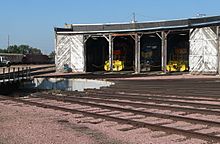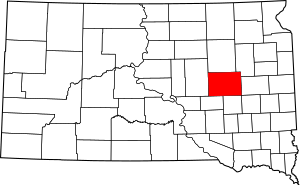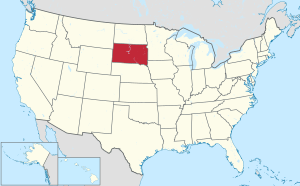Beadle County, South Dakota facts for kids
Quick facts for kids
Beadle County
|
|
|---|---|

Chicago and Northwestern roundhouse in Huron, South Dakota.
|
|

Location within the U.S. state of South Dakota
|
|
 South Dakota's location within the U.S. |
|
| Country | |
| State | |
| Founded | 1879 (created) 1880 (organized) |
| Named for | William Henry Harrison Beadle |
| Seat | Huron |
| Largest city | Huron |
| Area | |
| • Total | 1,265 sq mi (3,280 km2) |
| • Land | 1,259 sq mi (3,260 km2) |
| • Water | 6.1 sq mi (16 km2) 0.5% |
| Population
(2020)
|
|
| • Total | 19,149 |
| • Estimate
(2023)
|
19,591 |
| • Density | 15.138/sq mi (5.8446/km2) |
| Time zone | UTC−6 (Central) |
| • Summer (DST) | UTC−5 (CDT) |
| Congressional district | At-large |
Beadle County is a county located in the state of South Dakota in the United States. In 2020, about 19,149 people lived there. This makes it the 11th largest county in South Dakota by population.
The main city and county seat of Beadle County is Huron. The county was officially started in 1879 and began operating in 1880. Beadle County is part of the Huron, SD area, which is a smaller city area.
Contents
History
Beadle County is named after William Henry Harrison Beadle. He was a Brigadier General and an important figure in education. The area was made a county by the Dakota Territory Legislature in 1879.
In 1880, the county was officially set up. Three county commissioners were chosen by Governor Nehemiah G. Ordway. These commissioners help manage the county. The first town in Beadle County was Cavour. However, Huron became the county seat when the commissioners first met there in July 1880.
Geography
The James River flows through the eastern part of Beadle County. The land in the county has gentle, rolling hills. These hills slope down towards the river valley.
The highest point in the county is in its southwest corner. It is about 1,841 feet (561 meters) above sea level. The lowest point is where the James River leaves the county. This is on the southern border, about 1,230 feet (375 meters) above sea level.
Beadle County covers a total area of 1,265 square miles (3,276 square kilometers). Most of this area, 1,259 square miles (3,261 square kilometers), is land. Only a small part, 6.1 square miles (16 square kilometers), is water.
Major Roads
Neighboring Counties
- Spink County - north
- Clark County - northeast
- Kingsbury County - east
- Sanborn County - southeast
- Jerauld County - southwest
- Hand County - west
Protected Natural Areas
Beadle County has several areas set aside to protect nature and wildlife. These are often called State Game Production Areas. They help keep the local environment healthy.
- Bob Roe Memorial State Game Production Area
- Brecken Slough State Game Production Area
- Cavour Lake State Game Production Area
- James River School State game Production Area
- Lake Byron Hogsback State Game Production Area
- Mallard Slough State Game Production Area
- Mud Lake State Game Production Area
- North Byron State Game Production Area
- Norwegian/Borden State Game Production Area
- Pheasant Country State Game Production Area
- Sand Creek State Game Production Area
- South Byron State Game Production Area
- South James River State Game Production Area
- Staum Dam State Game Production Area
- Third Street Dam State Game Production Area
- Upper Cain Creek State Game Production Area
Population Information
| Historical population | |||
|---|---|---|---|
| Census | Pop. | %± | |
| 1880 | 1,290 | — | |
| 1890 | 9,586 | 643.1% | |
| 1900 | 8,081 | −15.7% | |
| 1910 | 15,776 | 95.2% | |
| 1920 | 19,273 | 22.2% | |
| 1930 | 22,917 | 18.9% | |
| 1940 | 19,648 | −14.3% | |
| 1950 | 21,082 | 7.3% | |
| 1960 | 21,682 | 2.8% | |
| 1970 | 20,877 | −3.7% | |
| 1980 | 19,195 | −8.1% | |
| 1990 | 18,253 | −4.9% | |
| 2000 | 17,023 | −6.7% | |
| 2010 | 17,398 | 2.2% | |
| 2020 | 19,149 | 10.1% | |
| 2023 (est.) | 19,591 | 12.6% | |
| U.S. Decennial Census 1790-1960 1900-1990 1990-2000 2010-2020 |
|||
The population of Beadle County has changed over the years. In 2020, the county had 19,149 people living there. There were 7,369 households, which are groups of people living together. The average number of people in each household was about 2.31.
About 28.6% of households had children under 18 living with them. The median age of people in the county was 41.2 years. This means half the people were older than 41.2 and half were younger.
Communities
Beadle County has several cities, towns, and other communities.
Cities
- Huron (This is the county seat)
- Iroquois (partly in another county)
- Wessington (partly in another county)
Towns
Census-Designated Places
These are areas that are like towns but are not officially incorporated.
- Huron Colony
- Morningside
- Pearl Creek Colony
- Riverside Colony
- Shamrock Colony
Townships
Townships are smaller local government areas within the county.
- Allen
- Altoona
- Banner
- Barrett
- Belle Prairie
- Bonilla
- Broadland
- Burr Oak
- Carlyle
- Cavour
- Clifton
- Clyde
- Custer
- Dearborn
- Fairfield
- Foster
- Grant
- Hartland
- Huron
- Iowa
- Kellogg
- Lake Byron
- Liberty
- Logan
- Milford
- Nance
- Pearl Creek
- Pleasant View
- Richland
- Sand Creek
- Theresa
- Valley
- Vernon
- Wessington
- Whiteside
- Wolsey
Education
Beadle County is served by several school districts. These districts manage the public schools in different areas of the county.
- Doland School District 56-2
- Hitchcock-Tulare School District 56-6
- Huron School District 02-2
- Iroquois School District 02-3
- Miller Area School District 29-4
- Wessington Springs School District 36-2
- Willow Lake School District 12-3
- Wolsey-Wessington School District 02-6
See also
 In Spanish: Condado de Beadle para niños
In Spanish: Condado de Beadle para niños

